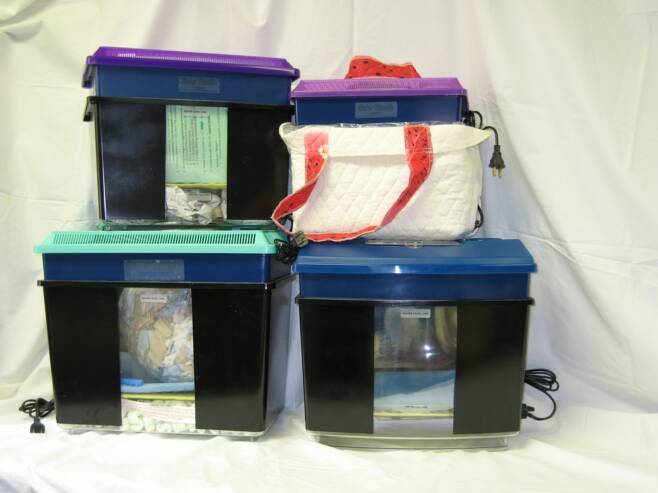
HAND-FEEDING SOFTBILLS & FINCHES
By
Wanda Barras
Electing to hand feed a tiny softbill nestling can be a daunting task. However, the death or illness of a hen or in cases of parental rejection are times when hand-feeding may be the only option or the tiny nestling is sure to die. There are times when a parent bird is brooding the babies, but just not feeding them properly. You have a choice of crossing your fingers and hoping the hen will eventually get it or you can choose to administer supplemental feedings to the chick(s) while they are still in the nest with the parent bird. After a short time the parents usually take over and begin to feed their babies.
Although, feeding and careing for a helpless nestling can be frightening and stressful. It is absolutely possiable to sucessfully raise a chick to independence. The following information will give you tools to help you care for a needy nestling.
WARM THE NESTLING
The nestling should feel warm to the touch. It is important that a cold chick be gently heated before any hand-feeding is attempted. If possible, let the parent or another brooding hen, warm the nestling. If this is not feasible, place the abandoned chick, comfortably, within a spare, clean nest that is lined with tissues. Put the tiny chick and makeshift nest inside a pre-heated incubator, brooder or some other makeshift, heated container. The temperature of the container should be approximately 90-95°F. Age and condition of the baby should be considered when setting brooding temperature. Older chicks will tolerate lower temperatures. Do monitor the brooder and condition of the chick regularly. Make sure the hatchling is warm and begging before any attempt is made to hand-feed. If chick does not beg, use a tiny artist’s paint brush or 1 cc pipette or tiny insulin syringe to dribble small amounts of electrolyte solution into the corner of the beak.
SUPPLEMENTAL FEEDINGS
In cases when the parent bird is just not feeding the chick yet still warming it supplemental feeding may be called for. Choosing to feed the baby while it is still in the nest is a better option that removing it from the nest to care for. It is more natural if the parent warms the chick while you feed until the parent catches on and begins to take over the feedings. Periodic supplemental feedings given to weak chicks while still in the nest, whether under the parent or foster parent will support the chick enough to eventually beg to be fed. This feeding by the hen may be sporadic at first, so supportive hand-feeding should continue until the hen does elect to take over.
When hand-feeding chicks in the nest, don’t completely satisfy the baby. The slightly empty crop will incline a still-hungry chick to beg, initiating feeding from the hen. The age and condition of the nestling affects how difficult the hand-feeding
Call: 1-800-555-1234
Call: 1-337-394-6683


 | ||||||

You are invited to utilize the resources and links to informational sites and forums.


 | ||||||
Visit our Web Store for All Your Avian Hand-Feeding & Breeder Supplies. .

will be. While young, healthy chicks beg when any motion is felt, weak chicks will lack the energy to demonstrate a feeding response. Touching the beak with the feeding implement may help initiate this response.
DEALING WITH DEHYDRATION
A rejected chick is usually suffering from dehydration. The first two to three feedings should be an electrolyte solution. Lactated Ringers, a hospital electrolyte solution, Ornalyte a powdered avian electrolyte and Pedialyte are all excellent electrolyte formulas. Warm the solution to a temperature of approximately 100 to 103°F. Initiate a feeding response and administer the solution using an appropriately sized feeding utensil. Tiny babies should be fed very small amounts very often. That is, at least every 10 to 15 minutes!
TINY MICRO-IMPLEMENTS ESSENTIAL
Small feeding implements are necessary when feeding finches. Tiny, one to three day-old hatchlings may benefit by using a small artist’s paint brush to get small amounts of the electrolyte solution into the baby. First feedings usually require no more than 2 or 3 drops of warmed feeding solution. Petite (0.5 to 1cc) syringes or pipettes also come in handy when feeding finches. Smaller sizes of soft latex tubing and gavage needles can also prove to be useful when feeding tiny hatchlings.
Place the end of the feeding instrument where the upper and lower beaks meet. This usually causes the baby finch to open his mouth (gape) and beg. He will lunge up, stick out his neck and open his mouth. Be ready. Get the end of the feeding implement into the gaping mouth and steadily release a drop of formula onto his tongue before he shuts his mouth. Do not squirt the formula down the throat! There is a chance that you may aspirate the chick by getting the food into the lungs. Soon, you will learn the rhythm required to feed baby finches. If the finch is not begging properly, the tiny artist’s paint brush dipped in warmed electrolyte solution can be laid along the edges of the beak and dribbled into the mouth. The feeding response is usually initiated after one or two feedings. It is best to feed small amounts often. As chicks mature feed as long as he begs, being careful not to overfeed.
GOING TO A MORE SOLID FOOD
When the chick is re-hydrated and displaying a healthy feeding response, it is time to begin feeding a semi-solid solution. For nestlings one to two days old, mix a solution of:
1 part Lactated Ringers
1 part Heinz or Gerbers rice cereal with applesauce
1 part spinach or garden vegetable jar baby food
NOTE: I have successfully substituted two parts Chicken Noodle Dinner baby food for first two ingredients.
Remember to feed small amounts of the warmed solution, often. As the chick gets older add small amounts of commercial hand-feeding formula to the original solution and increase amount of formula fed at each feeding. I have found Lafeabers H/F formula a good choice for canaries and finches. The commercial hand-feeding formula should first be re-hydrated using the Lactated Ringers electrolyte solution to the consistency of pudding. Add this pudding-like mixture in small amounts to the original solution. As the nestling matures, increase the amount of commercial formula to suit the baby’s appetite. Feed only freshly mixed food each time.
.
FREQUENT, ROUND-THE-CLOCK FEEDINGS
Because of a finch’s high metabolism, babies need to be fed very often. Depending on the age or condition of a hatchling, feedings can be as often as every 10-15 minutes, 30 minutes or every hour. Feeding frequency is dictated by the emptying of the crop. Finches are very fragile and require these frequent feedings in order to thrive. Feedings should be sustained almost round the clock, for the first week. Do not hand-feed finches on a whim. Hand-feed only in life or death situations! That is, if the parent or foster parents will not feed and the baby has no other chance of survival.
Finches are not the ideal candidate for hand-feeding. Hand-feed finch hatchlings only when absolutely necessary. Encourage fostering whenever possible and use supplemental feedings to support weak or rejected babies while still in the nest. Choose feeding utensils appropriate for the situation and be sure to have emergency supplies on hand at all times. When hand-feeding finches, you should be ready, willing and able!
The End
illustrations:



Belle Ècorce Farms'
Cage'N Bird---ARTICLES on Avian Hand Feeding & Husbandry
The helpful Artficle above, which is made available to you on line. The following articles including the article above is in Wanda's "A Common Sense Approach to Handfeeding". Available in the "Books & Video's" section of our Cage'N Bird Web Store.
INTRODUCTION TO HAND-FEEDING ---Hand-feeding basics for the beginner
DAY-ONE HAND-FEEDING ---Day-one Hand-feeding basics.
DEALING WITH CROP PROBLEMS: PART 1 ---Diagnosis & treatment.
CROP PROBLEMS, CANDIDA: PART 2--- Identification and treatment.
GUIDE TO GAVAGE FEEDING AND CROP EVACUATION---Lifesaving technique
UNDERSTANDING THE WEANING PROCESS ---What to expect and how to cope
SPLAYED LEG ---Orthopedic condition that can be corrected if identified early
KEYS TO SUCCESSFUL HAND-FEEDING---Identification, Diagnosis & Treatment
PROBIOTICS ---Probiotic therapy can help in the prevention of disease in aviary & nursery
HAND FEEDING TIPS AND HINTS---Useful Tips for hand-feeders
VINEGAR --- A natural disinfectant..
GSE ---Grapefruit Seed Extract its uses in the aviary and avian nursery
WHAT IS DE? ---Diatomaceous Earth, approved food additive, pesticide & natural wormer
THOUGHTS ON WEANING & DIET ---What foods are appropriate for weaning.
HAND-FEEDING FINCHES ---How to hand-feed tiny finches.
STAGES OF AVIAN DEVELOPMENT ---Development from hatch to weaning
Sanitation? Antiseptic? Disinfection? Sterilization? ---Understanding cleaning and disinfection products.
BACTERIA IN THE NURSERY ---Learn about good and bad bacteria & disease prevention.
THE BUSINESS OF HAND FEEDING ---Hand feeding for out. What should I charge

